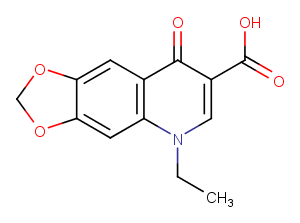Powder: -20°C for 3 years | In solvent: -80°C for 1 year


Oxolinic acid (Nidantin) is a synthetic antimicrobial related to NALIDIXIC ACID and used in URINARY TRACT INFECTIONS.

| Pack Size | Availability | Price/USD | Quantity |
|---|---|---|---|
| 250 mg | In stock | $ 34.00 | |
| 500 mg | In stock | $ 46.00 | |
| 1 g | In stock | $ 48.00 |



| Description | Oxolinic acid (Nidantin) is a synthetic antimicrobial related to NALIDIXIC ACID and used in URINARY TRACT INFECTIONS. |
| Targets&IC50 | Dopamine uptake:4.3 μM |
| In vitro | Oxolinic acid, a quinolone antibacterial agent, inhibits reversibly the ATP-dependent replicative DNA synthesis in permeable cell systems as well as in cellophane disk lysates[4]. It also inhibits bacterial DNA gyrase but not eukaryotic topoisomerases, reversibly binding gyrase subunit A in gyrase-DNA complexes, blocking supercoiling activity and inhibiting DNA synthesis at 0.5-5 μg/ml[5][6][7]. |
| In vivo | The antimicrobial agent oxolinic acid, injected i.p. in mice, induces a dose dependent increase in locomotor activity. the stimulant locomotor effect of oxolinic acid depends on the blockade of the neuronal dopamine uptake complex[2]. |
| Synonyms | Emyrenil, Nidantin, NSC 110364, Dioxacin, Urinox |
| Molecular Weight | 261.23 |
| Formula | C13H11NO5 |
| CAS No. | 14698-29-4 |
Powder: -20°C for 3 years | In solvent: -80°C for 1 year
DMSO: 2.5 mM
You can also refer to dose conversion for different animals. More
bottom
Please see Inhibitor Handling Instructions for more frequently ask questions. Topics include: how to prepare stock solutions, how to store products, and cautions on cell-based assays & animal experiments, etc.
Oxolinic acid 14698-29-4 Cell Cycle/Checkpoint DNA Damage/DNA Repair GPCR/G Protein Microbiology/Virology Neuroscience Dopamine Receptor DNA/RNA Synthesis Antibacterial Antibiotic Emyrenil dopamine inhibit DNA/RNA Bacterial Nidantin NSC-110364 Inhibitor uptake antimicrobial NSC 110364 NSC110364 urinary Dioxacin infections tract synthesis Urinox inhibitor
